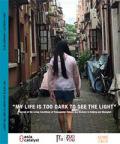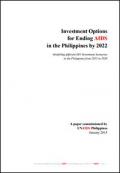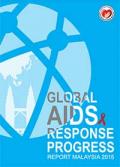What's New
Displaying results 2561 - 2570 of 4052

Resource | Publications,
This paper is an offshoot of the 2014 AIDS Epidemic Model (AEM) Report endorsed by the Department of Health in August 2014. The AEM report utilized a set of tools (AEM workbooks) that provided techniques for estimating and measuring the impact of past and future programs on the HIV epidemic in the Philippines (1970-2050).

Resource | Publications,
With the recent updates on the HIV epidemic status and the current program responses, the various strategic information, including updated surveillance results from the HSS and community behavioral surveillance (BSS) and integrated behavioral and biomarker surveillance (IBBS) among different key populations, updated intervention program results (HIV care and antiretroviral treatment, prevention of mother to child HIV transmission, etc.), population structural change, etc. The Bureau of Epidemiology, in cooperation with the Thailand and the Thai Working Group on HIV/AIDS Projections (2010), the A2 Thailand, and the Thailand MoPH-U.S. CDC Collaboration operate the Projection for HIV/AIDS in Thailand 2010 -2030 using the recent update version of Asian Epidemic Model, entitled AIDS Epidemic Model (AEM) for HIV projection among adult 15+ years old and the Spectrum for HIV projection among children lesser than 15 years old.

Resource | Publications,
This report describes the current continuum of testing for HCV, which is complex and expensive, which means that it is very challenging to implement in resource-limited settings. It examines the platforms/tests that are currently available across the range of required HCV testing from screening to confirmation and genotyping, fibrosis staging and treatment monitoring. The report also considers how the testing cascade for HCV may be simplified with the availability of DAAs, which would help make HCV testing attainable in resource-limited settings. Finally, it looks at the pipeline of tests/platforms for HCV that could be delivered at or near the point of patient care.

Resource | Publications,
Bhutanese health system has undergone a significant change during the last few decades. The change has been accompanied by improvement in the delivery of health care services to the people resulting in improved health outcomes of Bhutanese population. There has been increasing life expectancy, decreasing prevalence of communicable diseases, among others. Further, most of the Millennium Development Goals (MDG) has been realized, while some of them remain on track to be fulfilled by 2015. In addition, feedbacks from the populations also indicate lower report of sicknesses and increased satisfaction rate with health care services.
On the contrary, Bhutanese health system is grappling with a plethora of challenges. The double burden of diseases – emerging and re-emerging communicable diseases and increasing prevalence of non-communicable diseases – poses threats to the health of Bhutanese population. Health system also continues to face problems such as the shortage of health workforce and escalation of health expenditures, among others.
Therefore, the Status of Bhutan’s Health 2015 features the health status of Bhutanese population as of 2014. It is described under the following headings; 1) progress in health; 2) modifiable gaps in health; and 3) health system and its challenges.

Resource | Publications,
2014 was another milestone year for the Department of Health (DOH) as they continued their efforts to achieve Kalusugan Pangkalahatan.
With the support of partner agencies, the Department has been vigilant in preventing the spread of emerging and re-emerging diseases by taking appropriate measures such as surveillance, quarantine procedures, effective information dissemination and risk communication, and a hospital referral network system.
To allow more Filipinos to enjoy the benefits of universal health care, the department widened the reach and depth of financial risk protection by increasing membership in the National Health Insurance Program of the Philippine Health Insurance Corporation (PhilHealth) through the Point of Care Enrollment Program.

Resource | Publications,
The HIV epidemic in the Lao People's Democratic Republic is primarily affecting key populations in large urban areas, particularly in provinces situated along the Mekong River and Thailand. This report provides summary findings of the external reviews of the national health sector response to HIV conducted in 2014.
The review recognized a significant progress made on prevention, testing and treatment of HIV infection in the country, whereas identified two major gaps on diagnosing and linking people living with HIV to care and treatment. It provides a set of recommendations and key action points to further improve HIV response in the country.

Resource | Publications,
Based on research in Beijing and Shanghai, China this report focuses on the daily life, working conditions, access to services, and legal frameworks for transgender female sex workers in China. Transgender female sex workers face a broad array of discrimination in social and policy frameworks, preventing this highly marginalized group’s access to a wide spectrum of services and legal protections. They experience amplified stigma due to both their gender identity and their profession. Isolated and often humiliated when seeking public services, particularly in health care settings, has also led many to self-medicate and engage in dangerous transitioning practices, including on self-administered hormone use.
The research for this report illuminates that the community of female presenting sex workers is very complex and includes men who have sex with men, transgender individuals, and transsexuals. Their vulnerabilities to HIV and their varied health needs need to be carefully assessed, strategically targeted, and addressed. As China is in the process of drafting a new HIV/AIDS action plan for 2016-2020, now is a good opportunity to develop a specific strategy on HIV prevention and care for the transgender community.

Resource | Publications,
This paper is an offshoot of the 2014 AIDS Epidemic Model (AEM) Report endorsed by the Department of Health in August 2014. The AEM report utilized a set of tools (AEM workbooks) that provided techniques for estimating and measuring the impact of past and future programs on the HIV epidemic in the Philippines (1970-2050).

Resource | Publications,
The first case was reported in Malaysia in 1986. Since then, HIV has become one of the country’s most serious health and development challenges. At the beginning of the epidemic, injecting drug users was key driven factor that charted the graph by leaps and bounds as the country’s responses focused more on creating awareness and early detection through screening programmes in prisons and drug rehabilitation centers country wide.
Today there are 46% fewer new HIV infection than there were 15 years ago. Today there are 54% fewer new HIV infection among children below 13 years than there were 15 years ago. We are confident we can get to zero new HIV infections among children soon. Reaching MDG6 is not the end but a beginning of a meaningful journey to end AIDS. We will not be complacent but continue to thrive towards reversing and ending the epidemic despite the milestones achieved.
This report is testament to the growing body of evidence demonstrating that ending AIDS epidemic as a public health threat by 2030 is certainly doable though it appears ambitious.






